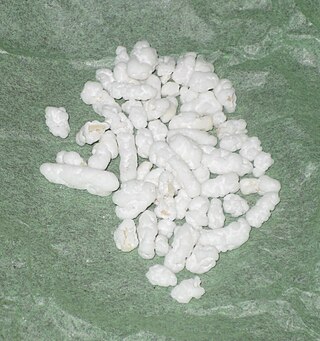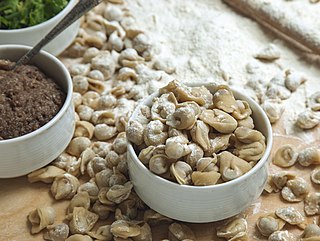
Kebab, kabob, kebap, or kabab (Kashmir) is roasted meat that originates from the Middle East. Many variants of the category are popular around the world, including the skewered shish kebab and the doner kebab with bread.

Pilaf, pilav or pilau is a rice dish, or in some regions, a wheat dish, whose recipe usually involves cooking in stock or broth, adding spices, and other ingredients such as vegetables or meat, and employing some technique for achieving cooked grains that do not adhere to each other.

Iranian cuisine is the culinary traditions of Iran. Due to the historically common usage of the term "Persia" to refer to Iran in the Western world, it is alternatively known as Persian cuisine, despite Persians being only one of a multitude of Iranian ethnic groups who have contributed to Iran's culinary traditions.

Chelow kabab is an Iranian dish consisting of steamed rice and one of the many varieties of Iranian kebab. It is considered the national dish of Iran, and was probably created by the time of the Qajar dynasty.

Najmieh Khalili Batmanglij is an Iranian-American chef and cookbook author. Born in Tehran, she fled the Iranian Revolution in 1979, moving first to France, then the United States, building a career as a cookbook author as she went. Her first book, published in French, was called Ma Cuisine d’Iran (1984), followed by eight cookbooks in English, from Food of Life (1986) to Cooking in Iran (2018). The Washington Post hailed her in 2018 as "the grande dame of Iranian Cooking."

Ottoman cuisine is the cuisine of the Ottoman Empire and its continuation in the cuisines of Turkey, the Balkans, Caucasus, Middle East and Northern Africa.

Yakhni, yahni (Turkish), or yahniya is a class of dishes traditionally prepared in a vast area encompassing South Asia, the Middle East and Southeast Europe or the Balkans.

Caspian cuisine is a regional cuisine found in Northern Iran, primarily found in the Mazandaran, Gilan, Alborz, and Golestan provinces. The recipes are diverse, just like the region's landscape. Nature in the Mazandaran region of Iran is distinct and varied sections with a mixture of coastal, plains, prairies, forests, and rainforests. The Mazandarani cuisine of coastal regions is very different from that of mountainous regions since people settled in the Alborz usually use the indigenous herbs, while coastal populations prepare dishes using local fish and Caspian (Mazani) rice with vegetables.

Baklava is a layered dessert made of filo pastry sheets, filled with chopped nuts, and sweetened with syrup or honey.

Mlabbas, and Noghl, or Nuql, or sugar-coated almonds, is a traditional Syrian, Iranian and Afghan confection. It is made by boiling sugar with water and rose water and then coating roasted almonds in the mixture. It can also be made with other nuts such as walnuts or other items. Noghl is often eaten along with tea.

Kuku or kookoo is an egg-based and often vegetarian Iranian dish made of whipped eggs folded in various ingredients. It is similar to the Italian frittata, the French quiche, or an open-faced omelette, but it typically has less egg than a frittata, and it cooks for a shorter amount of time, over a low heat, before turned over or grilled briefly to set the top layer. It is served either hot or cold as a starter, side dish or a main course, and is accompanied with bread and either yogurt or salad.

Kashk bademjan, alternatively kashk-e bademjan or Kashk o bademjan, is a staple Iranian dish made with "kashk and eggplant" – also the literal translation of its Persian language name. The dish is served as a dip and typically garnished with liquid saffron, sautéed onions, garlic and often walnuts. It can be consumed either as an appetizer or a main dish, and is typically eaten with fresh bread.

Joshpara is a kind of dumpling popular in Central Asia, South Caucasus and the Middle East. They are made of unleavened wheat dough squares filled with ground meat and condiments. In observance of the Islamic dietary rules, the meat filling is usually without pork.

Baghalaa polow ; is an Iranian dish of rice, fava beans and dill. In Persian, baghalaa means fava bean while polo is pilaf, a style of cooked rice. It is made by cooking rice and green broad beans in boiling water. When cooked, the rice and beans are layered with dill in a pan, and everything is baked in an oven until ready. Saffron water can also be added to the rice. It is typically served with meat. Like other Iranian traditional foods, the dish may be served at special occasions and family gatherings.

Shirin polo, also commonly known as Persian wedding rice or Rosh Hashanah rice, is a traditional Persian rice pilaf that is commonly served to mark special occasions such as weddings. It is a simplified version of morassa' polō, lit. 'jeweled rice'.
Louisa Shafia is an American chef and cookbook author. Her 2009 cookbook Lucid Food focuses on local and sustainable eating. The New Persian Kitchen (2013) features traditional Persian dishes as well as reinterpretations.

Khoresh karafs is a traditional Iranian dish. As the name suggests, celery is the main part of this dish.
















